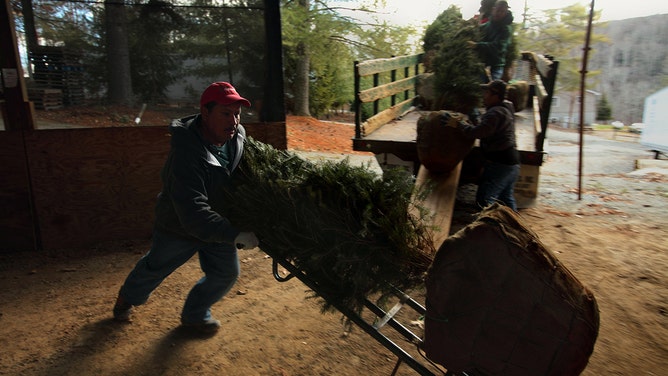North Carolina Christmas tree industry recovers from Helene as hope for holiday supply remains strong
Nearly three weeks after the most catastrophic storm most have seen in their lifetimes living in the western North Carolina mountains, many Christmas tree farmers are still reeling from its impacts, and the extent of its devastation is coming into focus.
North Carolina Christmas tree industry working to get back on its feet after Helene
North Carolina is the second-largest Christmas tree producer in the country and the industry is working to get ready even in the aftermath of Helene's devastation.
BOONE, N.C. – Helene was a devastating storm that spared no region of North Carolina, including the state's Christmas tree industry – the second-largest in the U.S.
The trees grown in the western part of the state are renowned for their quality, including soft needles, long-lasting aroma and strong branches. North Carolina Fraser fir trees are popular worldwide and have been chosen for the White House Christmas tree multiple times.
Nearly three weeks after the most catastrophic storm most have seen in their lifetimes living in the western North Carolina mountains, many Christmas tree farmers are still reeling from its impacts, and the extent of its devastation is coming into focus.
"We have a long way to go, but we have every confidence that in November, we will welcome our faithful friends to our local choose and cut farms and our wholesale Christmas trees will be on their way down the mountain, ready to help families celebrate the merriest season of all," said Jennifer Greene, executive director of the NC Christmas Tree Association.
RECOVERY EFFORTS UNDERWAY IN NORTH CAROLINA AS HELENE DEATH TOLL TOPS 250

Guest workers work at the Barr Evergreens christmas tree farm in Crumpler, North Carolina on Feb. 13, 2013.
(Carolyn Cole/Los Angeles Times / Getty Images)
According to Greene, the state's Christmas tree farmers, known for their resilience and determination, are well-equipped to overcome the challenges ahead. The organization said they remain optimistic that the supply of real North Carolina Fraser fir Christmas trees will not be significantly affected this holiday season.
The Tar Heel State boasts approximately 1,300 growers cultivating Fraser fir trees on an estimated 40,000 acres, with 96% of the production concentrated in the western North Carolina mountain region, according to the association.
"Christmas tree farming is a livelihood and a large economic contributor to the western North Carolina mountain region," Greene, said. "It will take some time to fully assess the extent and implications of damage to Christmas tree farms affected by the hurricane, but our farmers have weathered the storm and are ready to persevere."
At this point, Greene said they are still gathering information from their farmers regarding the extent to which their farms were impacted by Helene.
"The next step will be working together to create a plan for harvest and shipping as we prioritize the safety and welfare of our farmers, their families and their workers," she adds.
HELENE KILLS 11 MEMBERS OF THE SAME FAMILY AFTER MUDSLIDE DESTROYS THEIR COMMUNITY
Christmas tree industry works to recover from Helene
Jennifer Greene, executive director of the North Carolina Christmas Tree Association, says the industry is set to bounce back after the catastrophic damage of Hurricane Helene.
North Carolina Agriculture Commissioner Steve Troxler described Helene as the most devastating disaster the state had ever faced, surpassing previous weather-related catastrophes.
"I’ve seen a lot of ag damage, especially with the apple crop up in Henderson County. We also have a lot of fruit and vegetable producers in that area," he told Southeast Farm Press in an Oct. 3 telephone interview.
In one case, Troxler said the river has changed course and is now going through the middle of a large bottomland.
"it’s dangerous to even try to get to the fields," he added. "Most of the crops are gone. We are going to have some livestock mortality, there is no question about that."

